
The Murray cod is a large Australian predatory freshwater fish of the genus Maccullochella in the family Percichthyidae. Although the species is called a cod in the vernacular, it is not related to the Northern Hemisphere marine cod (Gadus) species. The Murray cod is an important part of Australia's vertebrate wildlife—as an apex predator in the Murray-Darling River system—and also significant in Australia's human culture. The Murray cod is the largest exclusively freshwater fish in Australia, and one of the largest in the world. Other common names for Murray cod include cod, greenfish, goodoo, Mary River cod, Murray perch, ponde, pondi and Queensland freshwater cod.
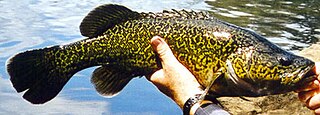
The eastern freshwater cod, also known as the eastern cod or Clarence River cod, is a large predatory freshwater fish of the genus Maccullochella and the family Percichthyidae, that occur in the coastal Clarence River system of north-eastern New South Wales. Eastern freshwater cod are closely related to the Murray cod of the Murray-Darling River system, and are considered an icon of the Clarence River system.
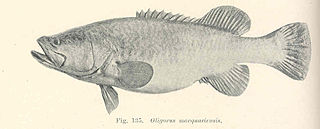
The trout cod or bluenose cod, is a large predatory freshwater fish of the genus Maccullochella and the family Percichthyidae, closely related to the Murray cod. It was originally widespread in the south-east corner of the Murray-Darling river system in Australia, but is now an endangered species.

The members of the family Percichthyidae are known as the temperate perches. They belong to the order Perciformes, the perch-like fishes.

The Macquarie perch is an Australian native freshwater fish of the Murray-Darling river system. It is a member of the family Percichthyidae and is closely related to the golden perch.

The golden perch is a medium-sized, yellow or gold-coloured species of Australian freshwater fish found primarily in the Murray-Darling River system, though a subspecies is found in the Lake Eyre-Cooper Creek system, and another subspecies, suspected to be ancestral to all other populations, is found in the Fitzroy River system in Queensland. Other common names for golden perch are "goldens", “yellowbelly” and "callop", the last generally used only in South Australia.
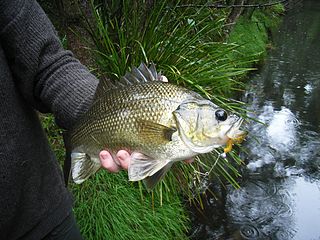
The Australian bass is a small- to medium-sized species of primarily freshwater fish found in coastal rivers and streams along the east coast of Australia. A member of the genus Macquaria from the family Percichthyidae, the Australian bass is an important member of the native fish assemblages found in east coast river systems. It is a native predatory fish and an extremely popular game fish species among anglers. The species was simply called perch in most coastal rivers where it was caught until the 1960s, when the name "Australian bass" started to gain popularity.

The two-spined blackfish is a species of temperate perch endemic to Australia.
The Mary River cod is a species of temperate perch native to the coastal Mary River system of southern Queensland, Australia. Mary River cod are one of Australia's most endangered freshwater fishes and are notable for being the most northerly of the four Maccullochella cods found or once found in coastal river systems of eastern Australia.
The Richmond River cod was a form of Maccullochella cod, now believed to have been eastern freshwater cod, Maccullochella ikei, that occurred naturally in the Richmond River system, an east coast river system in north-east New South Wales, Australia.
The Brisbane River cod was a unique form of Maccullochella cod that occurred naturally in the Brisbane River system, an east coast river system in south east Queensland, Australia. The Brisbane River Cod was known as the Bumgur by the Jinibara people centred in the Kilcoy region and the junction of the Stanley and Brisbane Rivers. Their exact taxonomic status is not known, but based on several genetic studies it is suspected that Brisbane River Cod were a species intermediate between eastern freshwater cod of the Clarence River and Richmond River systems in northern New South Wales and Mary River cod of the Mary River in central Queensland.

Maccullochella is a genus of large Australian predatory freshwater fish within the family Percichthyidae. The genus Maccullochella was named after an early Australian fish researcher with the surname McCulloch.
Australia has over 5000 described species of fish, a quarter of which are endemic. Seafood and aquaculture are major and highly regulated industries, and fishing for marine and freshwater native fish is popular.

Galaxias olidus, the mountain galaxias, is a species of freshwater galaxiid fish widely found in southeastern Australia.
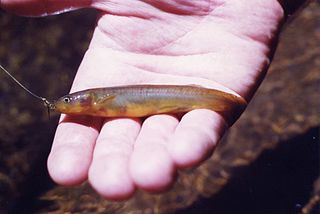
Galaxias is a genus of small freshwater fish in the family Galaxiidae, and are frequently referred to as the galaxiids. These highly adaptable fish are typically found at temperate latitudes across the Southern Hemisphere.

Gadopsis is a genus of temperate perches endemic to freshwater habitats in southeastern Australia. The genus was formerly considered to be in a family of its own, Gadopsidae.
Scottsdale Reserve is a 1,328-hectare (3,280-acre) nature reserve on the Murrumbidgee River in south-central New South Wales, Australia. It is 79 kilometres (49 mi) south of Canberra, and 4 kilometres (2.5 mi) north of Bredbo. It is owned and managed by Bush Heritage Australia (BHA), which purchased it in 2006. The purchase was supportive of projects aiming to connect existing fragmented remnant habitat such as K2C. Since the 1870s up until 2006, the land was used for agriculture – primarily sheep grazing with some minor cropping. A significant component of the Reserve has been cleared of native vegetation.

The southern pygmy perch, also known as the Tasmanian pygmy perch, is a species of freshwater ray-finned fish, a temperate perch from the family Percichthyidae which is native to south-eastern Australia and Tasmania.
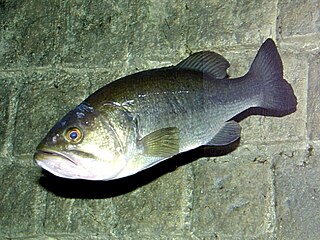
Centrarchiformes is an obsolete order of ray-finned fish, now included amongst the perciformes, with 17 previously included families. This order first appeared about 55.8 million years ago in the Eocene Era, and is composed primarily of omnivores. The order has a wide range that includes the continents of Australia and South America. Many Centrarchiformes look essentially perch-like, featuring a stocky build and a spine-bearing dorsal fin, and range in size from 2.5 cm in length, to 1.8 meters for the Maccullochella peelii. The order Centrachiformes is not recognized in the 5th Edition of Fishes of the World.













